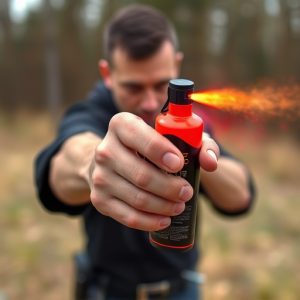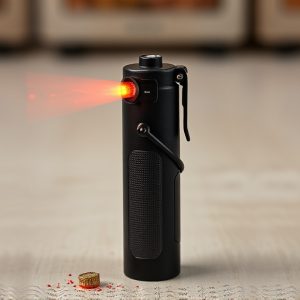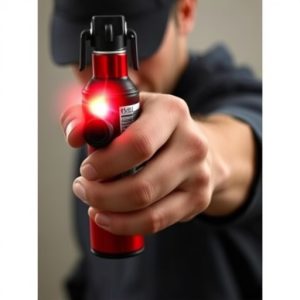Pepper Spray Gel vs Stream: Understanding Differences for Effective Self-Defense
This text compares pepper spray gel and stream, highlighting their key differences in personal prote…….
This text compares pepper spray gel and stream, highlighting their key differences in personal protection. Pepper spray gel, with its viscous formula, provides prolonged defense by causing immediate pain and blindness, ideal for extended emergencies or close-quarters combat. In contrast, pepper spray stream offers a quick but temporary defense with a concentrated aerosol, suitable for defending against multiple assailants at slightly farther distances. The choice between them depends on personal preference and threat level, ensuring individuals have the right tool for diverse scenarios. Effective training programs educate users on proper usage techniques, target acquisition, breathing exercises, and understanding spray range and effects. Risks include allergic reactions, burns, and eye damage if misused, emphasizing the importance of adhering to manufacturer guidelines and safety precautions.
“Personal protection sprays have become essential tools for self-defense, with two prominent forms: Pepper Spray Gel and Stream. This article delves into the intricacies of these inflammatory agents, exploring key differences between their formulations and effects. We’ll analyze their effectiveness in real-world scenarios, dissect application techniques and training needs, and discuss safety considerations including potential side effects. Additionally, we guide readers through choosing the ideal personal protection spray tailored to their specific requirements, focusing on the nuances of Pepper Spray Gel Vs Stream.”
- Understanding Pepper Spray Gel and Stream: Key Differences
- Effectiveness in Self-Defense: A Comparative Analysis
- Application Techniques and Training Requirements
- Safety Considerations and Potential Side Effects
- Choosing the Right Personal Protection Spray for Your Needs
Understanding Pepper Spray Gel and Stream: Key Differences
Pepper spray gel and stream are two distinct forms of personal protection sprays, each with unique properties that make them suitable for different scenarios. Understanding these key differences is crucial when choosing the right defense mechanism. One of the primary distinctions lies in their application methods and effects. Pepper spray gel, as the name suggests, comes in a viscous gel form that sticks to the target’s eyes, skin, and clothing, causing immediate pain and temporary blindness. This gel-based formula remains effective for an extended period, offering continuous protection during emergency situations.
In contrast, pepper spray stream is designed to emit a concentrated, liquid aerosol that travels straight and fast, reaching its target at high velocity. Unlike the gel, the stream disperses quickly, making it ideal for defending oneself from multiple assailants or those at a slightly farther distance. However, the effects are temporary as the spray wears off after a few minutes, requiring users to be prepared for potential follow-up encounters. The choice between these two depends on personal preference and the specific threat level, ensuring individuals have the right tool for self-defense in various situations.
Effectiveness in Self-Defense: A Comparative Analysis
In the realm of personal protection, especially during self-defense scenarios, understanding the effectiveness of different agents is paramount. One such comparison involves Pepper Spray Gel and Stream (a common type of pepper spray). The former, known for its thick, viscous consistency, claims to offer a more targeted and prolonged effect by adhering to skin and clothing. This characteristic makes it particularly effective in close-quarters combat, allowing users to disrupt an attacker’s vision and movement even at short range.
On the other hand, Stream pepper spray presents as a thinner, more aerosolized solution designed to create a large respiratory barrier. Its rapid dispersion can cover a wider area, making it advantageous for open spaces or situations where distance plays a role. While Gel may excel in close encounters, Stream’s ability to reach further distances could be a game-changer in diverse self-defense scenarios, ensuring folks are equipped with the right tool for any situation they might encounter.
Application Techniques and Training Requirements
When it comes to applying a personal protection spray, understanding the differences between pepper spray gel and stream is key. Gel formulations offer a more targeted approach, allowing users to project a thick, sticky mist that sticks to assailants’ eyes and skin, causing pain and disability. This method is particularly effective in close-quarters combat or when dealing with multiple aggressors. In contrast, stream sprays disperse a thin, wide jet of irritant, providing a larger coverage area but less concentrated impact. Users can easily defend themselves from a distance with this type of spray.
Training is an indispensable aspect of mastering these application techniques. Law enforcement agencies and self-defence instructors often conduct specialized sessions to educate individuals on the correct usage of personal protection sprays. These training programs cover various scenarios, ensuring users understand how to respond in different situations. Practicing target acquisition, learning proper breathing techniques for sustained use, and understanding the spray’s range and effect are all integral parts of the training process, empowering individuals to make split-second decisions and defend themselves effectively when faced with an attack.
Safety Considerations and Potential Side Effects
When considering protective sprays, it’s paramount to understand the differences between pepper spray gel and stream varieties, especially regarding safety. Pepper spray gel forms a sticky barrier on skin and clothing, potentially causing longer-lasting irritation and more significant side effects like difficulty breathing or vision impairment. On the other hand, stream sprays disperse in a mist, offering quicker knockdown but generally less residual impact.
Both types carry risks of allergic reactions, burns, and eye damage if not used properly. Inhaling pepper spray can lead to coughing, dizziness, and respiratory distress. Contact with eyes can cause severe irritation and pain. It’s crucial to follow manufacturer guidelines, use protective eyewear, and ensure adequate ventilation when deploying any inflammatory agent personal protection spray.
Choosing the Right Personal Protection Spray for Your Needs
When selecting a personal protection spray, understanding the difference between pepper spray gel and stream is key. Each has unique properties catering to distinct needs. Pepper spray gel, known for its thick consistency, offers a longer range and sticks to attackers, providing more time to escape. On the other hand, stream sprays distribute a fine mist, allowing for quicker application over shorter distances, ideal for close-quarters defence.
Consider your typical situations of use – whether it’s for personal safety while walking alone, outdoor activities, or self-defence classes – to make an informed choice. For broader areas and potential attackers at a distance, gel pepper spray is recommended. Stream sprays, however, are better suited for close encounters where swift action is required.
When considering self-defense options, understanding the nuances between Pepper Spray Gel and Stream is key. Both have proven effectiveness in deterring attackers, but each has unique properties. Gel offers better stickiness and range, while Stream provides wider coverage and easier application. Choosing the right spray depends on personal preferences and situations one might face. Safety should always be a priority, with proper training recommended to ensure responsible use. By considering these factors, individuals can make informed decisions about their personal protection, empowering themselves in potentially dangerous scenarios.


